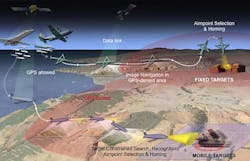Lockheed Martin to develop small, lightweight weapon seeker to attack targets without use of GPS
EGLIN AIR FORCE BASE, Fla., 18 Dec. 2015. Munitions experts at Lockheed Martin Corp. are developing a small, lightweight weapon seeker prototype to enable smart munitions to engage moving and relocatable targets during the day and at night in contested environments where Global Positioning system (GPS) satellite navigation may be unavailable.
Officials of the U.S. Air Force Research Laboratory Munitions Directorate at Eglin Air Force Base, Fla., announced an $8.2 million contract Thursday to the Lockheed Martin Missiles and Fire Control segment in Orlando, Fla., for this experimental seeker work.
The Air Force Research Lab awarded the contract to Lockheed Martin on behalf of the U.S. Defense Advanced Research Projects Agency (DARPA) in Arlington, Va., as part of the DARPA Seeker Cost Transformation (SECTR) program.
SECTR seeks to design and demonstrate a low size, weight, power, and cost (SWaP-C) seeker prototype capable of providing day/night navigation and precision terminal homing to a weapon platform which may engage moving, relocatable and stationary targets in a contested environment where GPS may not be reliably available.
The SECTR seeker will be for use in a heavily contested environment, where laser target designation is unavailable and where continuous intelligence, surveillance, and reconnaissance (ISR) support to the kill chain may not be available, DARPA officials explain.
Related: DARPA seeks to develop affordable smart weapons seeker for navigation and terminal homing
The SECTR seeker will have an open and modular hardware and software system architecture with government-owned interface standards, and will capitalize on the ability low-cost commercial technology to evolve rapidly with the pace of modern innovations.
In addition, the SECTR seeker will have terminal accuracy as good as, or better than, current seekers, DARPA officials say. The seeker will provide high-resolution imaging and range information for target recognition and optimum aim point selection, which will minimize the size and mass of kinetic warhead needed to destroy the target.
The DARPA SECTR program is important because critical gaps exist in U.S. military capability to target and destroy moving, relocatable, and stationary targets under GPS-jammed conditions using low-SWaP-C seekers that can operate during day and night conditions, DARPA officials say.
Moving and relocatable targets in particular pose continual strategic and tactical threats to the U.S. military and the U.S. homeland.
Related: Three companies set sights on precision navigation that works independently of GPS
The SECTR seeker will included sensor for GPS-free navigation and for target and aimpoint recognition; inertial measurement unit (IMU); GPS receiver; processor; mechanical and electrical systems for power and cooling; and interfaces to weapon guidance and communication systems.
story continues below
With these elements the SECTR seeker should contain all elements necessary for precision guided munition navigation and target homing functions, specifically to estimate its own position, velocity, and orientation to detect and recognize specific targets and aimpoints.
Although technically challenging, DARPA scientists say they believe Lockheed Martin can develop the low SWAP-C day/night seeker capability with an open and modular architecture. If Lockheed-Martin experts succeed in developing such a seeker, its technologies could be used for advanced low cost smart munitions planned or under development.
DARPA researchers say this kind of seeker technology has the potential for a broad range of weapons, and significantly bring down the cost per kill of suppressing enemy air defenses, as well as many other targets of opportunity.
Related: DARPA asks industry for ideas on augmenting inertial navigation with non-GPS technologies
In practice, the SECTR seeker would be cued to find a target in a certain area that other ISR systems previously had detected, tracked, identified, and selected for attack.
The seeker will use passive electro-optical and infrared (EO/IR) sensors in a strapdown configuration without gimbals, and a system-on-a-chip processor to achieve GPS-free navigation into the target area, and target recognition and aimpoint selection during the terminal phase.
DARPA officials say the SECTR program may award contracts to several different contractors, so it's likely that other companies will join Lockheed Martin in this effort. A total of 17 companies submitted bids for the SECTR program.
On this contract Lockheed Martin will do the work in Orlando, Fla., and should be finished by December 2016. For more information contact Lockheed Martin Missiles and Fire Control online at www.lockheedmartin.com/us/mfc, the Air Force Research Laboratory Munitions Directorate at www.eglin.af.mil/units/afrlmunitionsdirectorate, or DARPA at www.darpa.mil.

John Keller | Editor
John Keller is editor-in-chief of Military & Aerospace Electronics magazine, which provides extensive coverage and analysis of enabling electronic and optoelectronic technologies in military, space, and commercial aviation applications. A member of the Military & Aerospace Electronics staff since the magazine's founding in 1989, Mr. Keller took over as chief editor in 1995.

